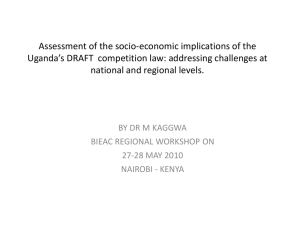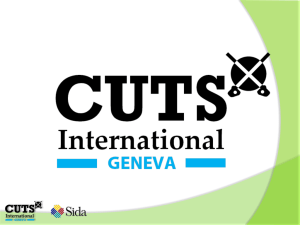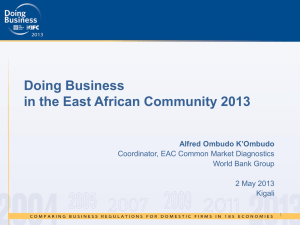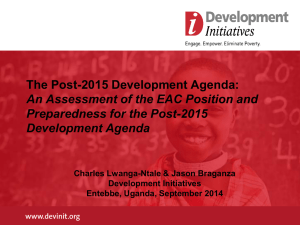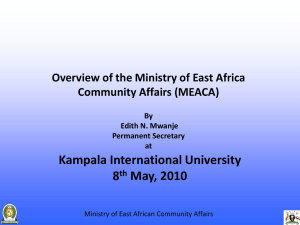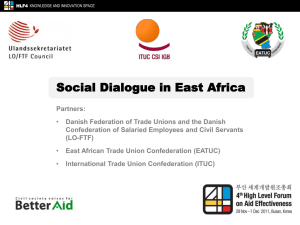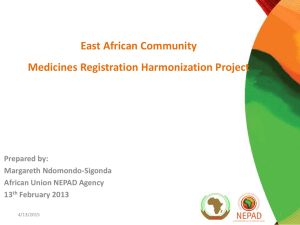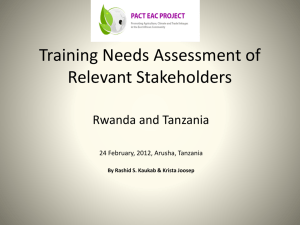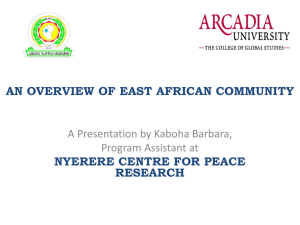Progress Report Presentation Sept 2013
advertisement
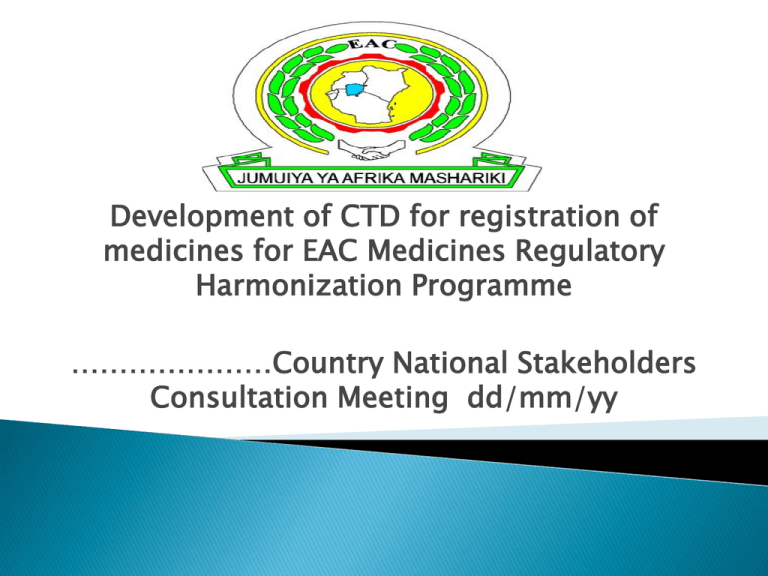
Development of CTD for registration of medicines for EAC Medicines Regulatory Harmonization Programme …………………Country National Stakeholders Consultation Meeting dd/mm/yy Background Composition of the TWG-MER Responsibility Progress Challenges Way forward Conclusion 2 Chapter 21 (Article 118) of the EAC Treaty ◦ Provides for harmonization of drug registration and regulation Harmonize drug registration procedures Harmonize national health policies and regulation and promote the exchange of information on health issues in order to achieve quality health within the Community. 3 Purpose: To harmonize medicines registration in the EAC Partner States in order to ◦ increase the rapid availability of safe, efficacious and good quality essential medicines in the region ◦ enable free movement of pharmaceuticals within the region to complement the implementation of the EAC Customs Union operational since 2010 Goal: To have a harmonized and functioning medicines registration system within the East Africa Community in accordance with national and internationally recognized policies and standards i.e. WHO & ICH] 4 Constituted by 12 members drawn from all the 6 EAC Partner States’ NMRAs. i.e. Kenya Pharmacy and Poison Board (future KFDA) National Drug Authority of Uganda Tanzania Food and Drugs Authority (TFDA) – Lead country Zanzibar Food and Drug Board (ZFDB) Rwanda Pharmacy Task Force (future RFMA) Department de la Pharmacie, du Médicament et des Laboratoires (DPML) of Burundi (Future ABREMA) 5 To develop harmonized technical requirements and guidelines for registration of human medicines. Develop EAC Common Technical Document (CTD) format for application for registration of human medicines in EAC. Present the developed CTD, technical requirements and guidance for application for registration of medicines in EAC to the Steering Committee for approval. 6 Develop assessment guidelines and Standard Operating Procedures (SOPs) for assessment of medicines dossiers. Identify and develop a list of vital essential and necessary (VEN) medicines that will be jointly assessed by EAC Partner States and present to the project Steering Committee for approval. Facilitate domestication of the agreed technical document for registration of medicines, guidelines and SOPs for application and assessment of dossiers. 7 Meetings held • 23 Video conferences - between July 2012 and August 2013 • 3 face to face meetings- in July, October 2012 and May 2013 • Drafting and Development of EAC – guidelines/documents 8 1. EAC Guidelines on Submission of Application for registration of Medicines Common Technical Document (CTD) with appendixes – mother document Provide guidance for applicants preparing a Common Technical Document for registration of medicines Describes how to organise applications based on the International Conference on Harmonisation of Technical Requirements 9 The CTD consists of 5 modules: • Module 1: Prescribes Administrative Information and Prescribing Information requirements, • Module 2: Quality overall summary (QOS), • Module 3: Quality (API and FPP), • Module 4: Non-clinical, • Module 5: Clinical 10 • Annexes Annex I – Covering letter. Annex II – EAC application form Annex III – Expert report. Annex IV – Letter of access for DMF/CEP. Annex V – Quality Overall Summary Annex VI – Quality review requirements. 11 2. Quality overall summary of module 2 and module 3: quality Assist applicants on the preparation of the Quality Module for generic medicinal products Provides clear general guidance on the format of presenting information Provide guidance on the technical and other general data requirements. 12 Quality overall summary (QOS) Overview of Module 3 Emphasize critical key parameters of the product Key issues that integrates information from sections in the Quality Module and supporting information from other Modules (e.g. qualification of impurities via toxicological studies). 13 Module 3: Main data on quality of API and FPP API data submission Options 1: EAC-Active pharmaceutical ingredient master file (EAC-APIMF) or Option 2: Full details in the Marketing Application Dossier (MAD). FPP – full documentation 14 3 . Requirements for stability studies Active pharmaceutical ingredient Finished pharmaceutical ingredient Address new and existing APIs/FPP Not applicable for biologicals – vaccines Stress stability Regulatory stability – accelerated and long term • Long-term • 30 °C ± 2 °C/75% RH ± 5% RH • Accelerated • 40 °C ± 2 °C/75% RH ± 5% RH 6 months 15 Storage conditions requirements for FMPs intended for storage in a refrigerator • • • Long-term 5 °C ± 3 °C 12 months Accelerated 25 °C ± 2 °C/60% RH ± 5% RH or • 30 °C ± 2 °C/65% RH ± 5% RH or • 30 °C ± 2 °C/75% RH ± 5% RH FMPs intended for storage in a freezer • 5 °C± 3 °C or 25 °C ± 2 °C or 30 °C ± 2 °C) • 16 Specify the requirements for the design, conduct, and evaluation of bioequivalence studies Immediate release and modified release dosage forms with systemic action Stipulates exemptions for carrying out in vivo bioequivalence (BE) In vitro dissolution tests as a surrogate for in vivo BE studies Other studies • • Comparative pharmacodynamics studies Comparative clinical studies 17 Outline procedures from submission of a dossier to the final outcome, timeframe and procedure for competent authorities to amend, where necessary the conditions of marketing authorization of a particular product. Provide guidelines on general requirements – language, font size etc Outline procedures for different types of applications; new, renewal & variation 18 EAC guidelines on submission of application for registration of human medicinal products (main guideline). EAC guidelines on therapeutic equivalence requirements. EAC guidelines on registration of fixed-dose combinations (FDCs EAC guidelines on biowaiver EAC list of standard terms for pharmaceutical dosage forms and routes of administration. 19 EAC guidelines on procedural aspects of application for registration of human medicinal products. EAC guidelines on stability requirements. EAC guidelines on labeling requirements. EAC common glossary of terms used in medicines registration. 20 10. Annexes to the EAC guidelines on submission of application for registration of human medicinal products (main guideline):Annex I – Covering letter. Annex II – EAC application form for marketing authorization of medicinal product. Annex III – Expert report. Annex IV – Letter of access for DMF/CEP. Annex V – Quality Overall Summary – Product dossier. Annex VI – Quality review requirements. 21 To consider and approve the developed draft documents as listed above, and which have already been approved by the project’s regional steering committee, for further approval processes Also -To continue supporting the national and regional initiatives and efforts that are towards the improvement of peoples lives -To continue participating in the approval processes that will follow at the regional level Build more consensus and advocacy for strengthening the existing national Medicines Regulatory Agencies 22 EAC guidelines on selection of comparator products EAC guidelines on application for variation of a registered medicinal product. EAC common assessment procedure. Training modules on evaluation EAC Active Pharmaceutical Ingredient (API) procedure Guidelines on requirements for registration of biological/biotechnological products 23 procedures for internationalization of the approved guidelines in Partner States regulatory systems is not yet in place Few face to face meetings versus workload (development of documents) All the 6 NMRAs involved in the project activitie are not at the same level and more funds than budgeted will be required to build capicities in Rwanda, Burundi and United Republic of Tanzania (ZFDB) 24 Capacity building activities planned/underway a) Twining programme (2nd quarter - 2013/14) b) Training on dossier assessment (3rd quarter ) c) Joint assessments (4th quarter) d) WHO/EAC joint assessment sessions (July and Sept 2013.....continuing) Appointment of TWG members for replacement More interactive sessions – face to face meetings at least 3 for this financial year 25 26
